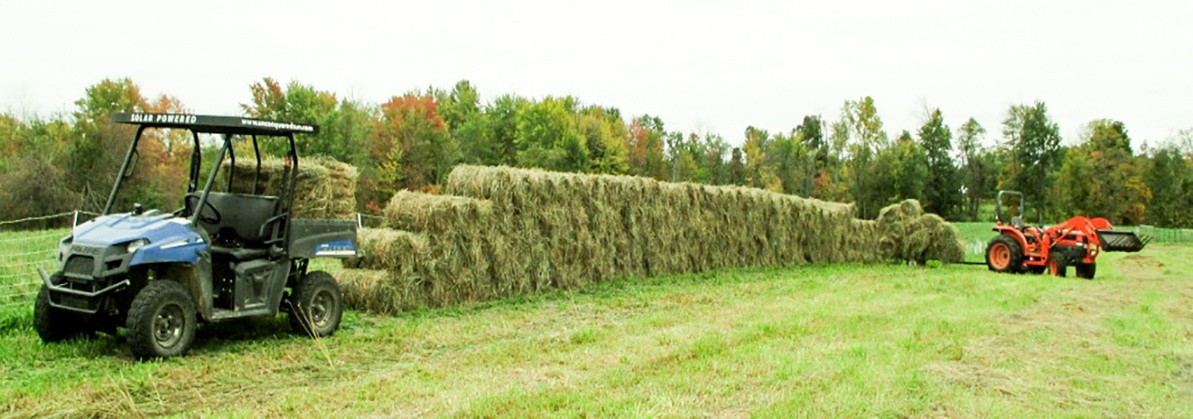Words from the Field
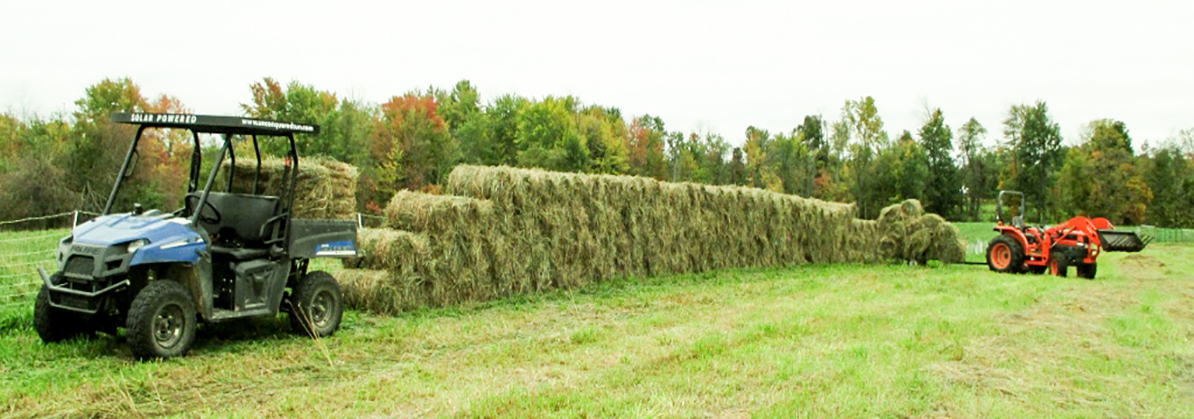
Last month in our blog "Haymaking Equipment for Sheep and Goat Owners" we discussed the ways our compact hay equipment, especially our mini-round balers, can increase the efficiency and productivity of sheep and goat farms. This month, we would like to share the first-hand account of one of our customers, Ron Klein, who with the help of TTD, has done just that.
Ron is the owner and operator of Windshadow Farm & Dairy, LLC in southwestern MI—a Grade A goat dairy milking 160 does. The following account, a letter written by Ron to TTD’s owner Pat Goodwin, shares how a mini-round baler has brought his operation greater haying independence and versatility. It also explains how he has been able to use the baler to bring more acreage into production and improve his rotational grazing program. He even shares how he has found mini-round bales to be a better choice for his operation when it comes to handling, stacking, storing and feeding out his hay.
Read on to see what Ron has to say:
January 7, 2018 Dear Pat,
It has warmed up to 13F. 24” of snow covers our pastures and our thoughts turn to hay.I wanted to add a few things to your comments on the value of round bales and the use of smaller haying equipment. We do have a JD 446 4 x 4 round baler that we use to harvest or largest seventeen-acre hay field for first cutting grass hay. That hay is longer and more efficiently harvested by one person with the 4 x 4 baler. However, we have integrated our Abbriata round baler (and the smaller format belt rake, drum mower and tedder from Tractor Tools Direct) into all aspects of our dairy farm.
“However, we have integrated our Abbriata round baler (and the smaller format belt rake, drum mower and tedder from Tractor Tools Direct) into all aspects of our dairy farm.”
First some background. We are located one mile north of the City of Bangor in SW Michigan. We are on 45 acres, 30 or which is in permanent pasture. We are a Grade A goat dairy and will be milking 160 dairy goats this coming season. We are pasture based and practice managed intensive grazing. Our creamery, Windshadow Farm Artisan Cheese, went on line in late 2017. We produce cheese from our own milk and cow’s milk from Moonique Dairy located south of us in Vandalia, Michigan.
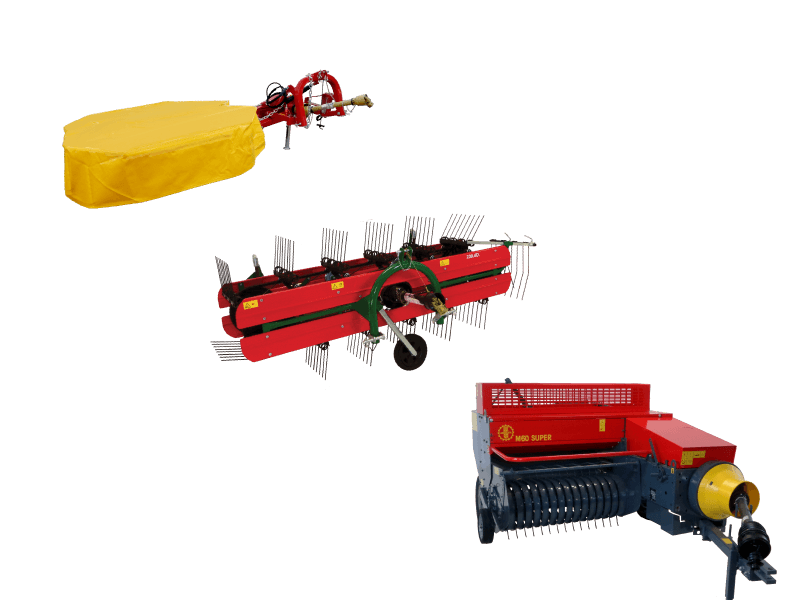
Managed intensive grazing is accomplished using electric twine on reels to define paddocks that our animals are released into. Power comes from our seven-strand high tensile electric fence powered by a 36 J Stafix energizer. The size of paddocks is determined by calculating the forage for our herd for a given period of time in pounds per inch per acre. The herd is removed at a determined forage height. It is simple setting up paddocks and determining the amount of forage using an NRCS grazing stick. How much available forage to enclose is determined by the estimated forage uptake per animal factoring in an estimate of what they will trample and leave uneaten. We see a more efficient use of our pastures since the does must eat both their dessert and Brussel sprouts while trampling uneaten forage facilitating incorporation into the soil and leaving urine and manure. We have seen a significant increase in the percent organic matter in our soil tests. The smaller equipment, and Abbriata in particular, fits well with smaller scale managed intensive grazing.
Taking hay has an important value for us in addition to stockpiling winter forage. We decided to start taking our own hay for several reasons. The first is because it was nearly impossible to hire someone to harvest it at peak nutrition since everyone is haying at the same time. We needed flexibility and control. If we purchased additional hay, we looked at it as both animal feed and fertilizer. A second and very important reason is that mowing and collecting hay helps control parasites, namely H. contortus (Barber-Pole worm), a significant problem for small ruminants. This worm is a voracious blood feeder and is now resistant to many of the widely used anthelminthic drugs. Understanding its life cycle allows control. Taking hay removes some of the infectious larvae and eggs and more importantly facilitates drying of the base of remaining grass which kills emergent worms. The infectious larvae require moisture to survive and are protected by the shade of the leaf canopy. We can take hay; allow regrowth and then graze when forage reaches a desired height; knowing that we will not have any significant, or any, reinfection of our herd.
We value the small baler for several reasons:
The turning radius is much smaller than our larger baler. When we plan our rotational paddocks, we can take hay from small areas several weeks ahead of the herd’s rotation schedule. During times of rapid growth, we can plan for more efficient use of smaller acreage. I have included some representative photos of our paddocks during peak early spring growth. We mob graze smaller paddocks (1/4-1/2 acre) for short times to maximize uptake of vegetative forage. We can take hay staying a few weeks ahead of the herd.
Taking hay from a smaller area lets us stay ahead of the weather. This has helped us in spring and fall when we have lake effect rains. I have included a photo of hay we, (we is Suzanne and I) took over a three day window of good weather in September of 2013. This is a field that was defined by smaller paddocks that we could not easily graze down before the forage base became rank.
I have always looked at lawns thinking about grazing and hay making. With the maneuverability of the and smaller equipment we can take “extra” hay. Our drive way is approximately 850 feet long with 16 feet of grass on either side (we need a place to put snow in winter). This is an area of .6 acre that we can take three cuttings of hay. I have a neighbor who calls this my long acre. I also can bale the grassed area in from of our barn and south of the house. Anyone with smaller acreage will appreciate adding an extra “free” acre of hay to their winter storage. Also, the Abbriata can be set up with the PTO and cut grass and forage brought to it and baled-I have done this once and likely will try it again this year.
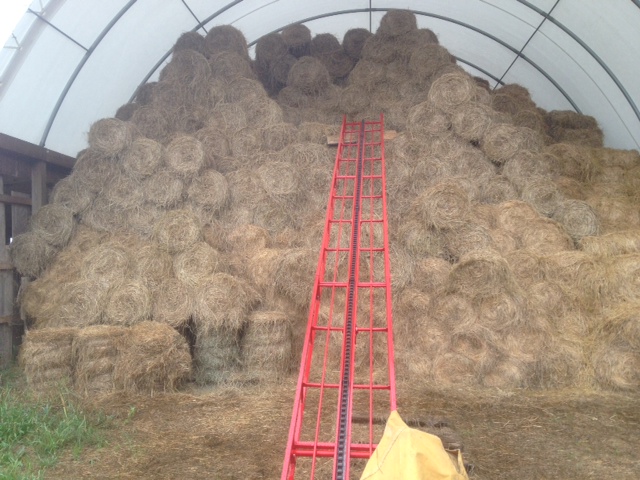
We were concerned with harvesting our small round bales, that is, pick up and putting hay into our barn. It is becoming increasingly difficult to find help in our area during hay season. And often it is just the two of us. So, I bought a moisture meter to be certain we were ready to bale dry hay and set the baler tension to produce a less tight pack but lighter bale. Given the length of the bales they are more easily picked up from the ends-no more grabbing squares by the string. Better leverage, less strain. We also use a low trailer and our solar powered Polaris Ranger EV to shuttle the bales to the barn. We designed the farm so the barns are either next to or just a short distance from our fields. In fact, our main hay field that is used for late season hay, (and post hay harvest grazing) is immediately east of our hay barns.
I was concerned with stacking and storage, understanding that we would lose storage area to rounds because of the way they stack and the resulting gaps between bales. Stacking was at first a problem especially using my hay elevator. The twine is wrapped around the bale and 90 degrees to the pick-up spikes, the twine caught on the spikes and snapped. The solution was to use the flat chain detacher and replace every other spike with a link of flat chain. The round bales are placed between the spikes and this configuration pushes the round bale up the elevator. The elevator still works for square bales. I have included a photo of our hay barn showing the elevator and stacked bales.
“The gaps between bales are not an issue; in fact, they are an added plus in providing air circulation to further dry the hay and keep it dry. The bales stack tight enough to walk on, dry easily and are stable if carefully stacked. As to the unfilled storage space- it is not significant.”
There is an additional benefit to us in feeding the small rounds. When we feed square bales, we need to break off flakes to put into our feeders. When I feed 4 x 4 baleage wrapped in plastic I need to unroll the bale and fork the baleage into our feeders. To maximize efficiency, I designed our feeders to accommodate our round bales. It may not seem like a time saver, but it is. Time spent doing extra tasks adds up. It takes time to cut twine and remove flakes from a square bale, plus square bales do not easily fit into our line feeders and hay is wasted. And it takes time to unroll bales and fork hay into feeders. Since we were adding some 80 feet of line feeders in our dairy barn we designed them to accommodate the round bales. So, when we feed the small rounds it is an easy matter to put them intact into the feeder and pull off the twine. I have included photos of our newer feeders. I increased the width and extended the slanted aisle side so the diminishing bale always rolls toward the animal side. The feeders were fabricated for us by Will Hart, The Improvisational Craftsman, LLC, in Pullman Michigan.
One other interesting thing about the Abbriata is that it can handle our marginal hay fields. By marginal I mean areas that are too steep or rough for tillage or areas I need to be very careful with the 4 x 4 baler. Dropping a large round bale can shift the center of gravity unbalancing the baler and generally I can’t comfortably use it. With care the smaller baler can handle hills and rougher ground and areas we cannot take the larger baler. We need to be alert for dead furrows and such, but we took some fine hay from a neighbor’s rough field that you could not use larger equipment on.
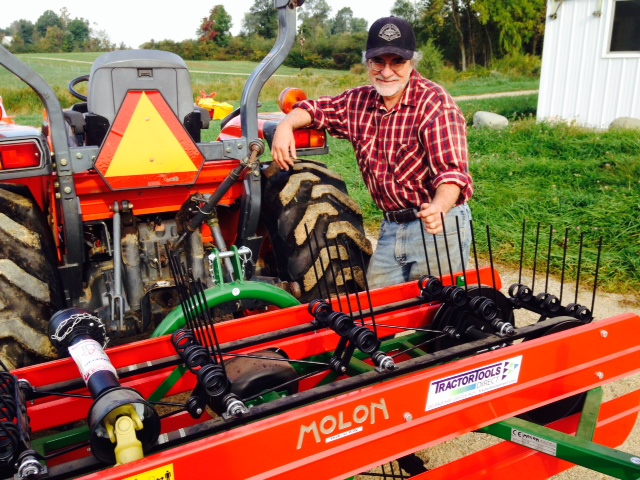
Overall the machine is easy to work on. The only exception is getting to a broken pick-up drive shear pin. The three-part housing is difficult to service in the field. Fortunately, we do not break many shear pins as long as we keep our windrows narrow and not have a lot of stemmy dry forage like Queen Ann’s lace. Blowing the machine out with compressed air and keeping it lubricated go a long way to avoiding jams.
I was concerned with service. We have had good advice and counsel. I have been talked through a few fixes and parts are shipped to us overnight. Tractor Tools Direct does everything they can to keep us up and running.
I appreciate your service and encouragement for our new business.
Thank you,
Ron Klein
Recent Posts
-
Boost Pine Straw Production Efficiency with Ibex Mini Round Balers
At Tractor Tools Direct, we're known for our high-quality hay equipment tailored for small farms …Dec 8th 2025 -
How to Winterize Your Tractor: Essential Maintenance Tips to Protect Your Investment
Farm equipment is one of the most valuable investments a farmer can make. At Tractor Tools Direc …Dec 1st 2025 -
Farm Tax ID Explained: Benefits, Eligibility, and How to Apply
As the end of the financial year approaches, it's a great time for small farmer operators to rev …Nov 12th 2025

